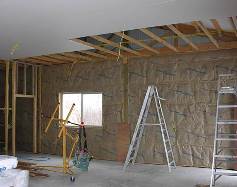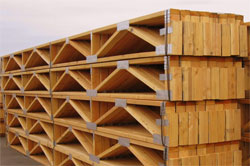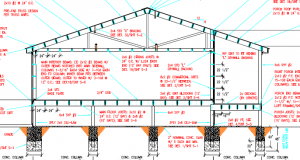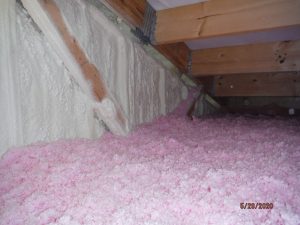Ceiling Loads
Considering a new pole building? An important question to ask is, “What will the cost be to upgrade the roof trusses to support the weight of a ceiling”?
Most post frame (pole) building trusses are not designed to support the dead weight (things which are permanently attached to the building) of anything other than the trusses themselves, required bracing and minimal wiring and lighting. In most cases, the necessary load carrying capacity on the bottom chord of the trusses is one psf (pounds per square foot).
 But – isn’t a ceiling fairly light? It will depend upon what the ceiling is going to be constructed of.
But – isn’t a ceiling fairly light? It will depend upon what the ceiling is going to be constructed of.
In the case of probably the lightest assembly – steel liner panels, the weight of the liner needs to be accounted for. A cubic foot of steel weighs 489.024 pounds. The thinnest 29 gauge steel measures .0142” thick. If the panels were totally flat, they would then weigh 0.58 psf (pounds per square foot). But liner panels are roll formed, with a 36 inch net coverage coming out of a coil which is typically about 40 inches in width. Figure a minimum thickness 29 gauge panel at about 0.65 psf.
Unless trusses are very close together (say four foot spacing or less), framing will need to be added to support the steel. Dry (19% maximum moisture content) 2×4 Hem-Fir weighs 0.98 plf (pounds per lineal foot), 2×6 1.54 plf. In case a heavier species or damp lumber is used, it is generally accepted to use 0.37 psf for 2×4, or 0.57 psf for 2×6 spaced every four feet.
Insulation is fairly light, but still must be accounted for. Fiberglass adds 0.04 psf per inch of thickness, cellulose 0.14 psf per inch.
This gives the weight added for a steel ceiling with 16 inches of cellulose blown in above at 3.26 psf (1.66 psf for fiberglass).
With the assumption fiberglass insulation will be blown in, I would normally recommend the bottom chord loading be increased to three psf for a 29 gauge steel liner.
How about other materials?
5/8” thick gypsum drywall weighs 2.2 psf, 7/16” osb (oriented strand board) 1.47 psf. Both will often require 2×6 supports every two feet for 1.14 psf. To handle 16 inches of fiberglass insulation, add four psf.
But what if the trusses were NOT designed to support ceiling loads?
Trusses engineered to support ceiling loads are going to be more expensive than those which do not. Depending upon the span of the truss and the applicable snow loads, the cost could be minimal, to very expensive.
With trusses of large spans, it may prove impossible or impractical to upgrade them to support the added ceiling loads.
Repairs (when they can be done) typically include doing one or more of the following:
- adding scabs along some or all of the top and bottom chords. Scabs typically are going to be equal to or larger in size, as well as grade of the original truss material. As truss chords are often high grade materials (msr, mel, #1 or Select Structural), it is rarely lumber which can be purchased from anyone except a truss manufacturer.
- Adding internal web members is rarely a “fix”. The same goes with flat steel plates. If the steel connector plates are inadequately sized for the larger loads, structurally rated plywood (usually 5/8″ or 3/4″) “plates” can be added, usually by both glue (not the “off the shelf” construction adhesive) and nailing in a prescribed pattern.
Any truss repair (such as increasing load carrying capacity) should always be designed by a registered design professional (an engineer), and a sealed drawing provided by the engineer.
It is always easier, and less expensive, to pay for the ceiling load to begin with.









